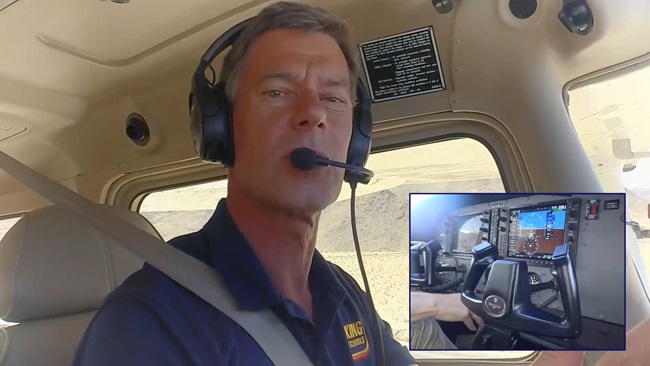Jim Lawson of Afton, Wyo., was descending through the clouds when the second tank ran dry.
The instrument-rated—but not current—pilot had departed for Ellensburg, Wash., in beautiful weather, but ground fog moved in at his destination, he said. So he headed toward his alternate, where ceilings were broken and he heard pilots on the frequency taking off and landing. When he got there, the clouds had closed in: He was low on fuel and trapped above the cloud layer. He needed help.
Three controllers at Seattle Tracon who helped Lawson look for an opening and then descend through the cloud layer for a dead-stick landing at Renton Municipal Airport were among those honored Feb. 1 with the National Air Traffic Controllers Association’s (NATCA’s) Archie League Medal of Safety Awards.
“I’m always amazed at the skill and dedication of these ATC professionals,” said AOPA Foundation President Bruce Landsberg, who served on the selection committee. “If you’ve got a problem, let ATC know as soon as possible—it could save your life.”
The awards highlight “saves” of 2011 in which a controller or team of controllers’ calm and quick thinking helped pilots “up here, wishing I were down there” make it down safely. NATCA presented the awards (named for the nation’s first air traffic controller, Archie William League) at the annual banquet during its annual Communicating for Safety Conference; Ken Greenwood, Josh Haviland, and Ryan Herrick, who came to the aid of Lawson, received the 2012 President's Award for most outstanding flight assist of the year.
Panic in IMC: ATC helps regain control
When the pilot of a Piper PA-32 Cherokee Six became disoriented in instrument meteorological conditions immediately after taking off from Spruce Creek Airport in Florida, calm voices and precise instructions helped him regain his composure—and may have saved his life.
The Air Safety Institute honored controllers Kenneth Palmer and Marc Ciprioni with its Flight Assist commendation at the Archie League Awards Banquet Feb. 1 for their actions guiding the pilot to a safe on-airport landing with no injuries or damage. The Air Safety Institute said the pilot was in a state of panic after reportedly nearly crashing twice, but Palmer “calmly gave precise instructions that allowed the pilot to regain control of his aircraft.” Ciprioni, a commercial pilot and CFI, opened up a separate sector to provide one-on-one instruction until the pilot regained his composure.
Beyond ‘Plan B’
When “Plan B” fails, it helps to have a calm voice on the frequency and ATC on your side. Lawson, a commercial pilot and A&P with inspection authorization, had headed out in his Mooney M20D/C Dec. 10 into a high-pressure system and clear skies on a mission to take Christmas presents to his son in Washington state. When Ellensburg was covered with clouds, he proceeded to Arlington. When that was closed in, too, he knew he was in trouble.
He contacted Seattle Center and let Greenwood, an 18-year veteran who was new to Seattle Tracon, know he was beginning to get low on fuel, “so I’d like to go direct to Auburn. Can I get down there?” the transcript reads.
No one had departed VFR from Auburn, Greenwood said. He gave a VFR vector toward Thun Field. Then the engine quit. Trapped on top of the cloud layer at 7,700 feet, Lawson switched to the left tank. The engine started running again, but he was low on fuel and had to get down: Greenwood vectored him toward the Auburn airport and cleared him to descend through the clouds.
The engine quit again.
“’Just concentrate on flying the airplane,’” Lawson later recalled thinking. “Then, of course it entered my mind that this may be the day that I don’t make it. But nevertheless I just keep flying the airplane.”
Meanwhile, a team of controllers was working to clear the way for a safe landing. Herrick, Greenwood’s trainer, oversaw the assist, while Haviland, an experienced pilot and flight instructor, sat next to Greenwood and offered help—while the controllers coordinated with Renton, Boeing Field, and Sea-Tac to keep the airspace clear for an emergency landing.
Lawson broke out at 2,200 feet. Greenwood directed him toward Renton Municipal, where he would still have to clear a thrust barrier before touching down. When he leveled out to clear it, Lawson thinks just enough fuel ran to the engine to restart the engine and miss the barrier. He landed safely and coasted off the ramp. His Mooney holds 24 gallons of fuel per tank, he said; when the linemen filled it up, it took 48.6.
Reflecting back on the incident, Lawson said a reminder from Greenwood on final approach drove home the professionalism and care demonstrated by ATC: “I think he realized how stressful things must be in the cockpit,” he said, “so on my final approach he reminded me to put my gear down.”
“Gear down and locked,” Lawson confirmed in the transcript. “Hey you know what? You just saved my life.”
Friends on the airwaves, nationwide
NATCA recognized controllers in nine regions for their dramatic saves in 2011. Landsberg served on the selection committee with Capt. Charles “Chuck” Hogeman, aviation safety chairman for the Air Line Pilots Association, International, and Dale Wright, NATCA’s safety and technology director, to select controllers who rose to the occasion in extenuating circumstances.
“Air traffic controllers juggle a variety of variables and complex scenarios,” the association said in the awards booklet. “Their ability to adapt to ever-changing situations while keeping their composure is a skill they have mastered. As a result of their commitment to perfection, our aviation system is the safest in the world.”
Winners of the awards helped distressed pilots handle low-fuel situations, inadvertent flight into instrument meteorological conditions, engine failures, icing, pilot incapacitation, and more. Listen to edited audio from each region to hear how these controllers helped pilots live to fly another day.


